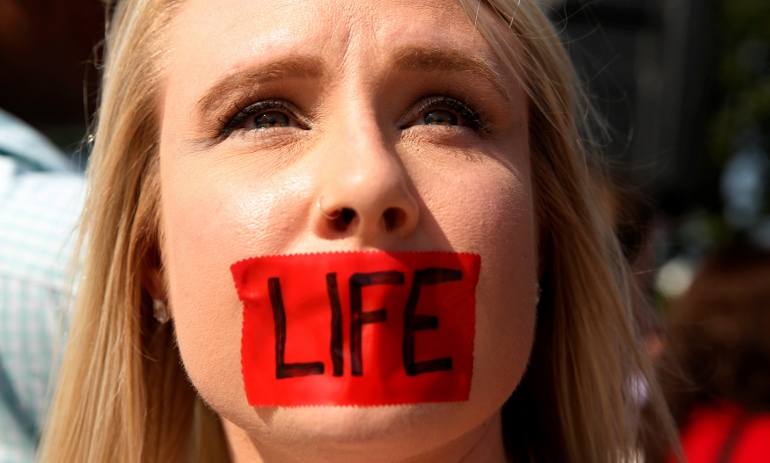
A pro-life supporter stands outside the U.S. Supreme Court June 27 during protests in Washington. In a 5-3 vote that day, the U.S. Supreme Court struck down restrictions on Texas abortion clinics that required them to comply with standards of ambulatory surgical centers and required their doctors to have admitting privileges at local hospitals. (CNS photo/Kevin Lamarque, EPA)
In this time of social and political polarization, we should remind ourselves of something that unites us: abortion.
Abortion is divisive when the focus is on legislative battles and court cases, like Monday's Supreme Court decision striking down a Texas law regulating abortion clinics.
But field research and interviews around the country show that reducing abortion as much as possible is a universal goal with broad consensus about how to achieve it.
In 1981, Betty Friedan wrote The Second Stage, in which she concluded that the second stage of feminism should focus on how our economic, health and day care systems can better support families.
What might be called the second stage of the abortion opposition movement may be coming to similar conclusions.
Roughly 75 percent of abortions in America occur when families can't afford a child, according to the Guttmacher Institute. Sixty-nine percent of women who seek abortions are "economically disadvantaged."
Between 2000 and 2008, the abortion rate decreased by 28 percent among higher-income women and rose by 18 percent among poorer females. Today, women with family incomes below the federal poverty level ($18,530 for a family of three) account for more than 40 percent of all abortions.
Recognition of the link between financial need and abortion was broad-based in research I conducted nationwide from 2009 to 2016. As Greg Boyd, an evangelical pastor in St. Paul, Minn., explained it: "A person could vote for a candidate who is not 'pro-life' but who will help the economy and the poor. Yet this may be the best way to curb the abortion rate."
Boyd reflects a growing consensus that addressing abortion is not a partisan position. "I am decidedly pro-life," the evangelical pastor Joel Hunter says. "But by working together instead of arguing, both sides can get what they want."
Also making the nonpartisan point, Susan Gallucci, a licensed social worker who runs a residence maternity home in Washington, D.C., is opposed to abortion, but uses Hillary Clinton's phrase "it takes a village" to explain her work: "So let's build the village," she says.
In programs around the country, building the support "village" begins with assistance during pregnancy but continues long after the child's birth and includes medical care; fathering classes; cooking, nutrition and budgeting classes; substance abuse programs; and legal assistance. These are conducted in the languages women speak. Gallucci offers English and Spanish, as well as Amharic for the local Ethiopian community.
Especially effective is the comprehensive assistance in "adopt a relative" programs that match women without a family nearby with "cousins" who provide emotional and much other support during pregnancy and, crucially, afterward.
One such effort (not limited to mothers) is the Wraparound program of A Wider Circle in Maryland, which puts together small teams for two years with the idea of getting people up on their feet. Other programs are the Family Support Office in Grand Rapids, Mich., and the Houston Pregnancy Health Center, which help new mothers for two years after they give birth and connects them with other agencies, from job training programs to low-cost housing.
"Sometimes, just help making that first intimidating phone call to the GED program makes all the difference," says Laurie Devilles, who runs a program in Austin, Texas. Women can remain in the program as long as needed. "We don't ever cut anyone off."
Sylvia Johnson in Houston helps also with acute issues such as trafficking and homelessness.
Her case managers speak English and Spanish and visit women in shelters and hospitals.
"We want to break the cycle of poverty by stressing education," she says. "It's difficult in this area of high poverty … but we keep talking. Maybe they catch something of it."
Two other services are in high demand and short supply: day care and adoption. The U.S. spends 0.4 percent of gross domestic product on public support for day care and early childhood education. New Zealand, the Scandinavian countries and France spend over 1 percent of GDP.
The U.S. also has 1 million abortions per year and 1 million families waiting to adopt a child. Those I spoke with across the country emphasized the need for adoption (traditional and "open") to be expedited and low-cost.
Funding for programs like Johnson's and Devilles' comes from the private and faith-based sectors. But the extensive referrals -- to low-cost housing, day care, GED and more -- are often to publicly funded government programs.
Cooperation among private, faith-based and government programs is a growing reality.
One opponent of abortion, a retired Mississippi firefighter whose church runs a crisis pregnancy center, holds that funding, like the programs themselves, should not be a partisan issue.
"If people are educated and interested in the subject," he said, "they might try to see what the right thing would be for the country instead of being polarized."
[Marcia Pally teaches at New York University, Fordham University and Humboldt University. Her latest book is Commonwealth and Covenant: Economics, Politics, and Theologies of Relationality.]
